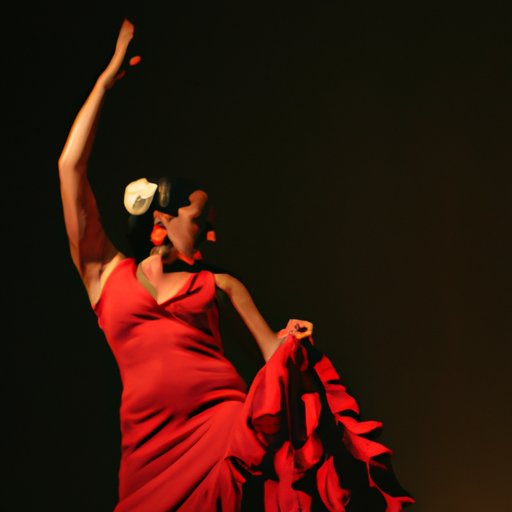Introduction
Flamenco is a Spanish art form that combines music, singing, and dance. It’s a passionate and intense performance style that has been popularized around the world. In this article, we’ll explore the history and cultural significance of flamenco dancing, as well as its various techniques and styles.
A Historical Overview of Flamenco Dancing
Origins of Flamenco
Flamenco has been around for centuries, and its exact origins are not known. According to some scholars, flamenco is derived from the traditional music and dance of the Romani people (or Gypsies), who arrived in Spain during the 15th century. Other sources suggest that flamenco was influenced by the music and dance of the Moors, a North African ethnic group who ruled over Spain for centuries.
Evolution of Flamenco
Flamenco has evolved over time, incorporating aspects of various musical and dance styles. During the 19th century, flamenco was heavily influenced by Andalusian folk music and was further developed by professional musicians and dancers. By the 20th century, flamenco had become a recognized art form and was performed in theaters and other public venues.

Exploring the Cultural Significance of Flamenco
Flamenco as a Symbol of Spanish Identity
Flamenco is seen as a symbol of Spanish identity and culture. According to a study published in the International Journal of Heritage Studies, flamenco is “the most important cultural asset of Spain” and “a powerful tool for nation-building”. The study also found that flamenco has been used as a means of expressing national pride, particularly during times of political conflict.
Flamenco and Gender Roles
Flamenco has traditionally been associated with gender roles. Men are usually seen as the lead performers, while women are typically cast in supporting roles. However, there are some female flamenco dancers who have achieved fame and recognition in their own right. For example, the late Carmen Amaya was one of the most influential female flamenco dancers of all time.
Characteristics of Flamenco Dance Styles
Basic Steps of Flamenco
Flamenco is characterized by its intricate footwork and body movements. The basic steps of flamenco include the zapateado (foot stamping), taconeo (heel clicking), and marcaje (marking). These steps are often combined with arm movements and facial expressions to create a dramatic effect.
Different Sub-Styles of Flamenco
There are several different sub-styles of flamenco, each with its own unique characteristics. These include baile (dance), cante (singing), and toque (guitar playing). Each style requires its own set of techniques and skills, so it’s important for dancers to be familiar with all three elements.

Understanding the Techniques Behind Flamenco Dancing
Posture
Good posture is essential for flamenco dancers. Dancers should keep their backs straight and their heads held high. The arms should be relaxed at the sides, and the feet should be slightly apart.
Movement
Flamenco movements are sharp and precise. The dancer should move from one side to the other with a sense of purpose and control. Movements should be graceful and elegant, but also full of passion and emotion.
Footwork
Footwork is an important part of flamenco dancing. Dancers should pay attention to the rhythm of the music and use the appropriate steps and patterns. Footwork can range from simple steps to complex combinations.
Arm Work
Arm work is another important element of flamenco. Arms should be used to emphasize the rhythms of the music and add drama and emotion to the performance. Arms should be kept close to the body, and hands should be open and relaxed.

The Role of Music in Flamenco
Types of Music Used in Flamenco
Music is an essential part of flamenco dancing. Traditional flamenco music is usually played on the guitar, but other instruments such as the cajón (wooden box drum) and palmas (hand claps) are also used. Other types of music, such as Latin and Arabic, are sometimes incorporated into flamenco performances.
The Impact of Music on Flamenco Performance
The music used in flamenco performances has a major impact on the overall feel of the performance. Different types of music can evoke different emotions in the audience, making the performance more exciting and engaging. The music can also influence the movements of the dancers, inspiring them to move with more energy and intensity.
Notable Flamenco Performances and Festivals
Major Flamenco Festivals
Flamenco festivals are held throughout the world, showcasing the best flamenco dancers and musicians. Some of the most renowned festivals include the Festival de Jerez in Spain, the Festival del Cante de Las Minas in La Unión, and the Festival Internacional del Cante de las Habaneras in Cuba.
Famous Flamenco Dancers
Flamenco has produced some of the most talented and celebrated dancers in the world. Notable flamenco dancers include Joaquín Cortés, Antonio El Bailarín, and Rafael Amargo. These dancers have gained worldwide recognition for their skill and artistic expression.
Conclusion
Flamenco is a vibrant and passionate art form that has captivated audiences around the world. With its roots in Spanish culture, flamenco combines music, singing, and dance to create a unique and mesmerizing performance. From its origins to its various techniques and styles, flamenco is an art form that deserves to be appreciated and celebrated.
(Note: Is this article not meeting your expectations? Do you have knowledge or insights to share? Unlock new opportunities and expand your reach by joining our authors team. Click Registration to join us and share your expertise with our readers.)
